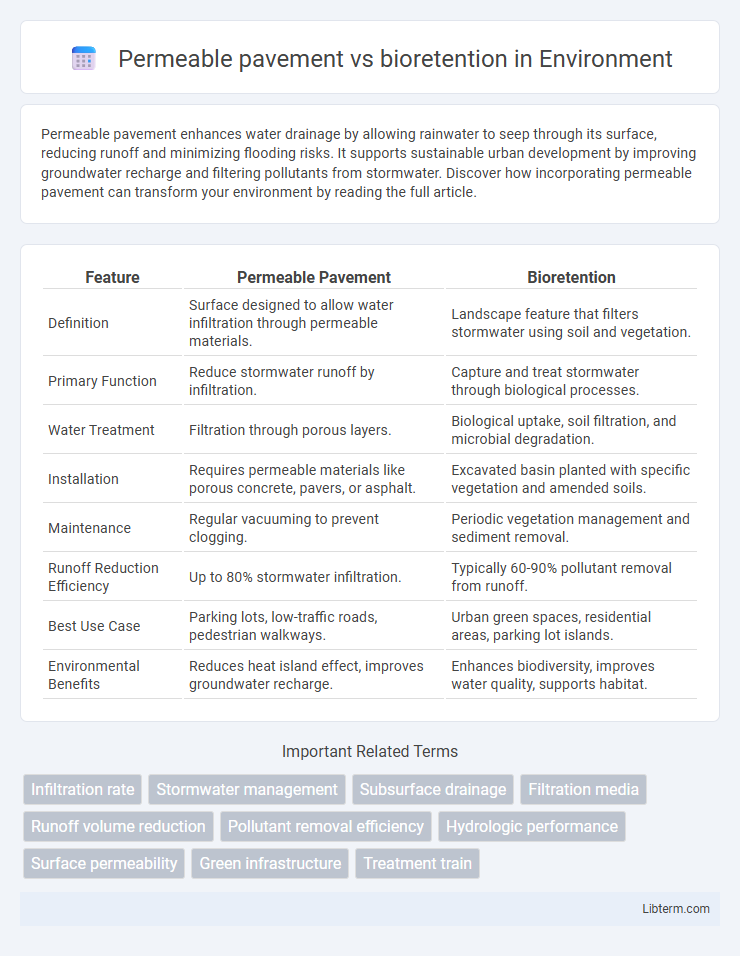Permeable pavement enhances water drainage by allowing rainwater to seep through its surface, reducing runoff and minimizing flooding risks. It supports sustainable urban development by improving groundwater recharge and filtering pollutants from stormwater. Discover how incorporating permeable pavement can transform your environment by reading the full article.
Table of Comparison
| Feature | Permeable Pavement | Bioretention |
|---|---|---|
| Definition | Surface designed to allow water infiltration through permeable materials. | Landscape feature that filters stormwater using soil and vegetation. |
| Primary Function | Reduce stormwater runoff by infiltration. | Capture and treat stormwater through biological processes. |
| Water Treatment | Filtration through porous layers. | Biological uptake, soil filtration, and microbial degradation. |
| Installation | Requires permeable materials like porous concrete, pavers, or asphalt. | Excavated basin planted with specific vegetation and amended soils. |
| Maintenance | Regular vacuuming to prevent clogging. | Periodic vegetation management and sediment removal. |
| Runoff Reduction Efficiency | Up to 80% stormwater infiltration. | Typically 60-90% pollutant removal from runoff. |
| Best Use Case | Parking lots, low-traffic roads, pedestrian walkways. | Urban green spaces, residential areas, parking lot islands. |
| Environmental Benefits | Reduces heat island effect, improves groundwater recharge. | Enhances biodiversity, improves water quality, supports habitat. |
Introduction to Permeable Pavement and Bioretention
Permeable pavement utilizes porous materials such as porous asphalt, pervious concrete, or interlocking pavers to allow stormwater to infiltrate through the surface, reducing runoff and promoting groundwater recharge. Bioretention systems, including rain gardens and bioswales, are designed to capture, filter, and treat stormwater through soil and vegetation while enhancing water quality and supporting urban green infrastructure. Both methods form critical components in low impact development (LID) strategies for sustainable stormwater management and mitigating urban flooding.
Key Differences: Permeable Pavement vs Bioretention
Permeable pavement and bioretention are two effective stormwater management practices but differ significantly in design and function. Permeable pavement uses porous materials allowing water to infiltrate directly through surfaces like parking lots, reducing runoff and promoting groundwater recharge, while bioretention involves landscaped depressions with engineered soils and plants to filter and retain stormwater. The key differences lie in permeable pavement's structural role supporting traffic loads and bioretention's emphasis on vegetation-based pollutant removal and habitat creation.
How Permeable Pavement Works
Permeable pavement functions by allowing water to infiltrate through its porous surface, reducing surface runoff and promoting groundwater recharge. It consists of interconnected void spaces or permeable materials like porous asphalt, pervious concrete, or permeable pavers that filter and direct stormwater into the underlying soil layers. This infiltration process effectively manages urban stormwater, decreases pollutant loads, and mitigates flooding compared to traditional impervious surfaces.
How Bioretention Systems Function
Bioretention systems function by capturing stormwater runoff in engineered soil media, where pollutants are filtered through layers of sand, organic matter, and vegetation roots. These systems promote infiltration and evapotranspiration, reducing stormwater volume and improving water quality before it percolates into underlying soil or storm drains. The plant roots and microbial activity within bioretention cells also enhance nutrient uptake and biological degradation of contaminants.
Environmental Benefits Comparison
Permeable pavement reduces stormwater runoff by allowing water to infiltrate through surfaces, minimizing flood risks and recharging groundwater. Bioretention systems enhance water quality by filtering pollutants through soil and vegetation, promoting habitat diversity and carbon sequestration. Both methods mitigate urban heat island effects and support sustainable water management but differ in maintenance and biodiversity benefits.
Installation and Maintenance Requirements
Permeable pavement installation involves grading, base layer preparation, and laying specialized permeable materials such as porous asphalt or concrete, requiring careful compaction to maintain structural integrity and infiltration capacity. Maintenance demands regular vacuuming or pressure washing to prevent clogging and preserve permeability, along with occasional repairs to damaged sections. Bioretention systems require excavation, soil amendment, and planting native vegetation, with maintenance focusing on sediment removal, vegetation management, and monitoring infiltration rates to ensure effective stormwater treatment and flow.
Cost Analysis: Initial and Long-Term
Permeable pavement typically incurs higher initial installation costs, ranging from $7 to $15 per square foot, due to materials and site preparation, but offers long-term savings through reduced stormwater fees and minimal maintenance requirements. Bioretention systems generally have lower upfront expenses, approximately $5 to $10 per square foot, yet involve ongoing maintenance costs, including vegetation care and sediment removal, which can increase lifetime expenses. Cost-effectiveness depends on project scale, site conditions, and intended benefits such as water quality improvement and runoff volume reduction.
Effectiveness in Stormwater Management
Permeable pavement effectively reduces stormwater runoff by allowing water to infiltrate through its porous structure, directly recharging groundwater and minimizing surface pooling. Bioretention systems enhance stormwater quality by filtering pollutants through engineered soil and vegetation, while also promoting infiltration and evapotranspiration. Studies show permeable pavement excels in volume reduction, whereas bioretention provides superior pollutant removal and groundwater recharge benefits.
Suitability for Urban and Rural Settings
Permeable pavement is highly suitable for urban settings due to its ability to reduce surface runoff and improve stormwater infiltration on impervious surfaces like parking lots and sidewalks. Bioretention systems excel in both urban and rural areas by filtering pollutants through vegetation and soil, making them ideal for managing diffuse runoff in residential neighborhoods and agricultural landscapes. Selecting between permeable pavement and bioretention depends on site-specific factors such as space availability, soil permeability, and maintenance capacity.
Choosing the Right Solution for Your Site
Permeable pavement effectively manages stormwater by allowing water to infiltrate directly through surfaces such as porous concrete or pavers, making it ideal for parking lots or low-traffic areas with impervious surfaces. Bioretention systems use engineered soil and vegetation to treat and absorb runoff, which is suitable for sites requiring pollutant filtration and enhanced groundwater recharge, especially in landscapes with limited space. Selecting the right solution depends on site-specific factors such as soil type, drainage capacity, pollutant load, and land use to ensure optimal stormwater management and environmental benefits.
Permeable pavement Infographic

 libterm.com
libterm.com